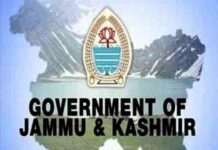Srinagar
Almost half the recruitments into militant ranks in the Valley after the killing of Hizbul Mujahideen commander Burhan Wani came from within 10 km of the residences of killed militants or encounter sites and these recruitments took place within 40 days of the encounters, reports claimed.
According to a report published by Indian Express, these are among the findings of security agencies in J&K, part of a report on militancy and recruitment in the region that set the stage for the Ramzan ceasefire.
The report analysed 43 encounters since November 5, 2016, until April 26 this year, in which 77 militants were killed. After the death of Burhan Wani on July 8, 2016, 121 militants have been killed and 216 local youths joined militancy. Of these, 104 were directly linked to the killing of militants in their area or a killed militant belonged to their area, the report said.
Consider the key findings of the report, which analysed the circumstances around these 104 recruits:
Each encounter sets off a surge in recruitments and new inductions into militancy far exceed militants killed in operations rendering even successful counter-insurgency a zero-sum game.
Militant killings anywhere trigger emotions across the Valley but in most cases, there is a strong correlation between the area of recruitment and number of militants killed from that area.
No wonder then that 67 of the 104 recruitments took place within 15 km from a killed militant’s residence, 48 of these were within a radius of 10 km.
41 per cent of all new recruits were within 10 km of the encounter site, 27 per cent within 11 and 20 km and 18 per cent between 10 and 15 km, Indian Express reported.
Recruitments between 2010 and 2018 into different militant organisations came from 354 villages, including nine from one village – Brath Kalan Sopore and seven militants each from three villages – Heff Zainpora, Redwani Bala and Arwani Bijbehara.
94 local militants were active in the Valley in early 2016, which rose to 113 in 2017 and at the beginning of 2018, there were 149 active militants.
In 2016, 33 militants were killed while 88 youths were recruited and in 2017 while 80 militants were killed, 131 were recruited into militancy.
Of the 461 local youth who joined militancy since 2010, 331 came from South Kashmir, the report mentioned.
Inspector General of J&K Police, Kashmir zone S P Pani told The Indian Express that the increase in local recruitment into militancy has been the “biggest challenge”.
We have been trying to dissuade local recruitment. Until now, 11 youngsters (who had joined militant ranks) have come back. Five (new recruits) were caught alive during encounters,’’ he said. “It is imperative that local recruitment is contained.”
The report on the trends in local militancy since 2016 suggests that there are a “host of circumstances” that “draw a correlation between the militants killed in encounters and the corresponding new inductions”.
According to the report, the killing of local militants in encounters “is part of a circle” that “acts as a catalyst to push further recruitment”.
The killing of civilians, who gather at encounter sites to protest, adds to the anger. “A single encounter in an area today draws severe law and order situations ending up many a time in the attack on the encounter site. (and) the deaths of protesters,” states the report.
“These protesters are usually residents of adjoining areas and also sometimes from areas not necessarily close to the encounter site. The deaths of these protesters further trigger protests supplemented by large funeral processions. Such a charged environment is a perfect blend of emotions and anger that is required to attract militant recruitment,” Indian Express reported.
Security agencies also indicated that funerals of killed militants witnessed pledges to join militancy.
“It has been observed that many a time, friends of killed militants manifest a tendency of pledging to join militancy on seeing the dead bodies and funerals of their friends. During the Bamnoo encounter, which took place in Rajpora, Pulwama where Jahangir Khanday of Keller was killed, his friend joined militant ranks on spot at the encounter site,” says the report.
“Large funerals of militants have also witnessed the presence of active militants who give gun salutes to their killed associates. The presence of militants in these funerals not only eulogises the deaths of militants but at the same time brings active militants into open interaction with civilians. Such an interaction is one of the first and important steps in facilitating recruitment.”
The data shows an uptick in recruitments after encounters. “While in some instances the reaction to the encounter in the form of recruitment is brisk, there are instances where it might take a few months to see the after-effects. Such a tendency may be attributed to the paucity of weapons and inability to get into contact with active cadres,” says the report.
The report indicates that while there have been successful operations, militancy “in no way seems to have taken a back seat”.
“From month to month the number of militant killings has been followed up by further recruitment outnumbering the killings and thereby raising the graph of the total number of militants each year. Even in the face of successful counterinsurgency operations, 94 local militants were active in the valley at the beginning of 2016 which rose to 113 at the beginning of 2017 and finally at the beginning of 2018, the number stood at 149,” states the report.
In 2018, 26 militants were killed while 46 fresh recruits were reported. Four were killed in January against 15 recruitments. None killed in February but five joined militant ranks and seven were killed in March against ten new recruits. In April, 18 militants were killed and 16 local youth joined militancy.
“What is noteworthy is that while from January (2016) up to July (2016) an average 4 militants were killed monthly and six would get recruited, but post Burhan Wani’s killing in July (2016), 35 militants got inducted into the militant ranks in the following three months of August, September and October,” says the report.
“In 2016, whereas an average of fewer than 3 militants was killed each month in the year, more than 7 at an average got recruited. It is evident that the killing of HM Commander Burhan Wani created a surge in militant recruitment across the valley in general and South Kashmir in particular.”
After Wani’s killing, security agencies have found that 35 youth became militants influenced by his killing in next three months. Except for three youth (two from Bandipore and one from Handwara), all of them belonged to South Kashmir, the report said.
The analysis of the data related to local militancy in Kashmir between 2010 and 2018 has also shown the militant presence concentrated in 29 clusters. The Pulwama cluster (comprised of 29 villages) and Tral Awantipora cluster (28 villages) has had the largest militant recruitment with 37 militants each since 2010. reported Indian Express.















